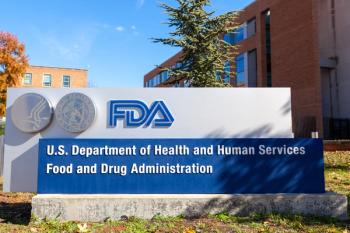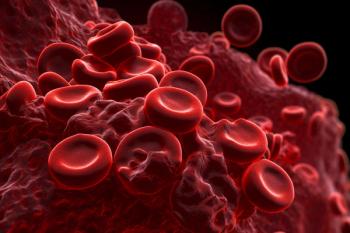
Efanesoctocog alfa Prophylaxis Offers “Efficacious Prevention” to Children With Severe Hemophilia A
The drug was FDA approved as antihemophilic factor (recombinant), Fc-VWF-XTEN Fusion Protein-ehtl (Altuviiio) in February 2023.
Once-weekly efanesoctocog alfa prophylactic therapy provided high-sustained factor VIII activity and “highly efficacious protection” against bleeding episodes in children with severe hemophilia A, according to research results published in the New England Journal of Medicine.1
Efanesoctocog alfa received FDA approval as antihemophilic factor (recombinant), Fc-VWF-XTEN Fusion Protein-ehtl (
Results of the phase 3 XTEND-1 clinical trial (
In the current study, (XTEND-Kids,
A total of 74 male patients (age <6 n=38, age 6 to <12 n=36) were enrolled, 97% of whom completed the study. Prior to the study, all but 1 patient received prophylaxis with a factory VIII replacement therapy; 70% of these patients were utilizing extended half-life products, requiring doses twice a week or every 3 days (range, every 2 days-every 7 days). Overall median number of exposure days to efanesoctocog alfa was 53 (range, 3-72), with 89% having at least 50 exposure days.
Median annualized rate of treated bleeding episodes was 0 (IQR, 0.00-1.02), with a model-based estimated mean overall annualized rate of treated bleeding episodes of 0.89 (95% CI, 0.56-1.42). Estimated mean annualized rates of bleeding into joints, of spontaneous bleeding, and of traumatic bleeding were 0.59 (95% CI, 0.27-1.28), 0.16 (95% CI, 0.08-0.30), and 0.44 (95% CI, 0.27-0.70), respectively. In total, 64% of participants experienced no bleeding episodes, 88% had no spontaneous bleeding episodes, and 82% had no episodes of bleeding into joints.
Ad hoc sensitivity analyses of 73 patients demonstrated an estimated mean and median annualized bleeding rate of 0.61 (95% CI, 0.42-0.90) and 0.00 (IQR, 0.00-1.02). A total of 43 treated bleeding episodes occurred, 41 of which were resolved with 1 efanesoctocog alfa injection.
Among all 74 participants, mean annualized efanesoctocog alfa consumption rate per patient was 3003.2±394.0 IU/kg. Consumption was 3115.6±488.6 IU/kg in those aged 6 years and younger, and 2884.7±207.9 IU/kg in participants aged 6 to younger than 12 years. Mean weekly prophylactic doses were 56.7±5.1 IU/kg and 53.2±2 IU/kg in patients younger than 6 and aged 6 to younger than 12.
READ MORE:
Mean overall Hemophilia Joint Health Score improved from 2.2±5.5 points at baseline to 1.6±4.88 points at week 52 (change, -0.6±6.0 points). Mean change Haemo-QoL score was -2.5±10.5 points in the 14 patients with available data.
In terms of safety, 84% of patients experienced at least 1 adverse event; 4% of these were determined to be related to efanesoctocog alfa therapy. Twelve percent of patients had at least 1 serious adverse event, none of which were determined to be related to treatment. Common adverse events included upper respiratory tract infection, pyrexia, nasopharyngitis, and pain in arms or legs, among others.
Study limitations include the small sample size. Researchers noted that a larger sample of previously treated patients, followed for a longer period of time, as well as assessments of previously untreated patients, “would be useful in understanding immune response and the potential immunogenicity” of efanesoctog alfa. XTEND-ed (
“Once-weekly efanesoctog alfa provided high sustained factor VIII activity and highly efficacious protection against bleeding episodes in children with severe hemophilia A, a population in which this goal has been difficult to achieve without burdensome treatment regimens,” the researchers concluded.
READ MORE:
References
Malec L, Peyvandi F, Chan AKC, et al; the XTEND-Kids Trial Group. Efanesoctocog alfa prophylaxis for children with severe hemophilia A. N Engl J Med. 2024;391(3):235-246. doi:10.1056/NEJMoa2312611
FDA approves once-weekly Altuviiio, a new class of factor VIII therapy for hemophilia A that offers significant bleed protection. News release. Sanofi. February 23, 2023. Accessed July 18, 2024.
https://www.sanofi.com/en/media-room/press-releases/2023/2023-02-23-21-00-00-2614759 von Drygalski A, Chowdary P, Kulkarni R, et al; XTEND-1 Trial Group. Efanesoctocog alfa prophlyaxis for patients with severe hemophilia A. N Engl J Med. 2023;388(4):310-318. doi:10.1056/NEJMoa2209226
Newsletter
Pharmacy practice is always changing. Stay ahead of the curve with the Drug Topics newsletter and get the latest drug information, industry trends, and patient care tips.




